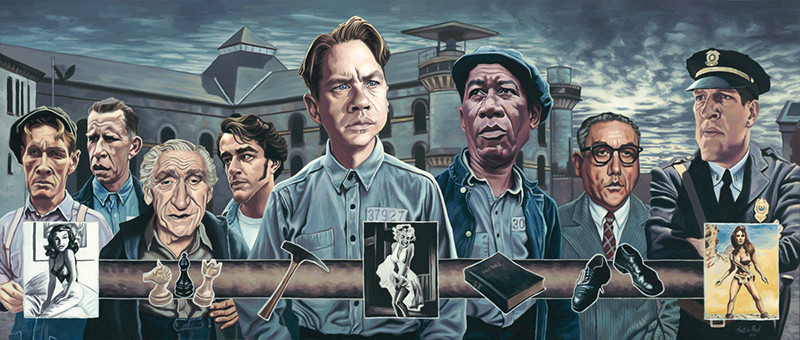Lesson Four - The Shawshank Redemption
.
Introduction
Lesson Four - The Shawshank Redemption
Duration - 8 blocks (8 x 80 min + homework)
"Fear can hold you prisoner. Hope can set you free." - The Shawshank Redemption tagline

"The Shawshank Redemption is a 1994 American drama film written and directed by Frank Darabont, loosely based on the Stephen King Rita Hayworth and Shawshank Redemption. The film stars Tim Robbins as Andrew 'Andy' Dufresne and Morgan Freeman as Ellis Boyd 'Red' Redding.
"The film portrays Andy spending nearly two decades in Shawshank State Prison, a fictional penitentiary in Maine and his friendship with Red, a fellow inmate. Despite a lukewarm box office reception that was barely enough to cover its budget, The Shawshank Redemption received favorable reviews from critics and has since enjoyed a remarkable life on cable television, VHS, DVD and Blu-ray.
"In the the movie was nominated for seven awards - Best Picture, Actor (Morgan Freeman), Adapted Screenplay, Editing, Cinematography, Original Score, and Sound Mixing, but, in the shadow of 1994's big winner, Forrest Gump, did not win a single one.
"In 1998 Shawshank was not listed in AFI's 100 Years... 100 Movies, but nine years later (2007), it placed at the 72nd position on the revised list, outranking both Forrest Gump (76th) and Pulp Fiction (94th), the two most critically acclaimed movies from the year of Shawshank's release.
"In 1999, film critic Roger Ebert listed Shawshank on his 'Great Movies' list, and in reader polls by the film magazine Empire, the film ranked fifth in 2004, first in 2006, and fourth in 2008 on the lists for greatest movie of all time." - Wikipedia
"Roger Ebert suggests that the integrity of Andy Dufresne is an important theme in the story line, especially in prison, where integrity is lacking. Andy is an individual of integrity (here referring to adherence to a code of morality) among a host of criminals, and guards, with little integrity. Additionally, the film's dominant themes of hope, original sin, redemption, salvation, and faith in the afterlife have led some critics to interpret the film as a Christian parable. Some Christian reviewers have referred to it as a film "true to Christian principles." In the director's commentary track on the tenth anniversary DVD, Darabont denies any intent to create such a parable, and calls such interpretations of the film 'fantastic'. Others have also pointed out that the film's tidy dispatching of its principal antagonists would seem to have more to do with Old Testament retribution than New Testament redemption. In addition, Andy's destruction of a Bible to enable his escape hints at a more pragmatic outlook.
"Angus C. Larcombe suggests that the film provides a great illustration of how characters can be free, even in prison, or unfree, even in freedom, based on one's outlook in life." - Wikipedia